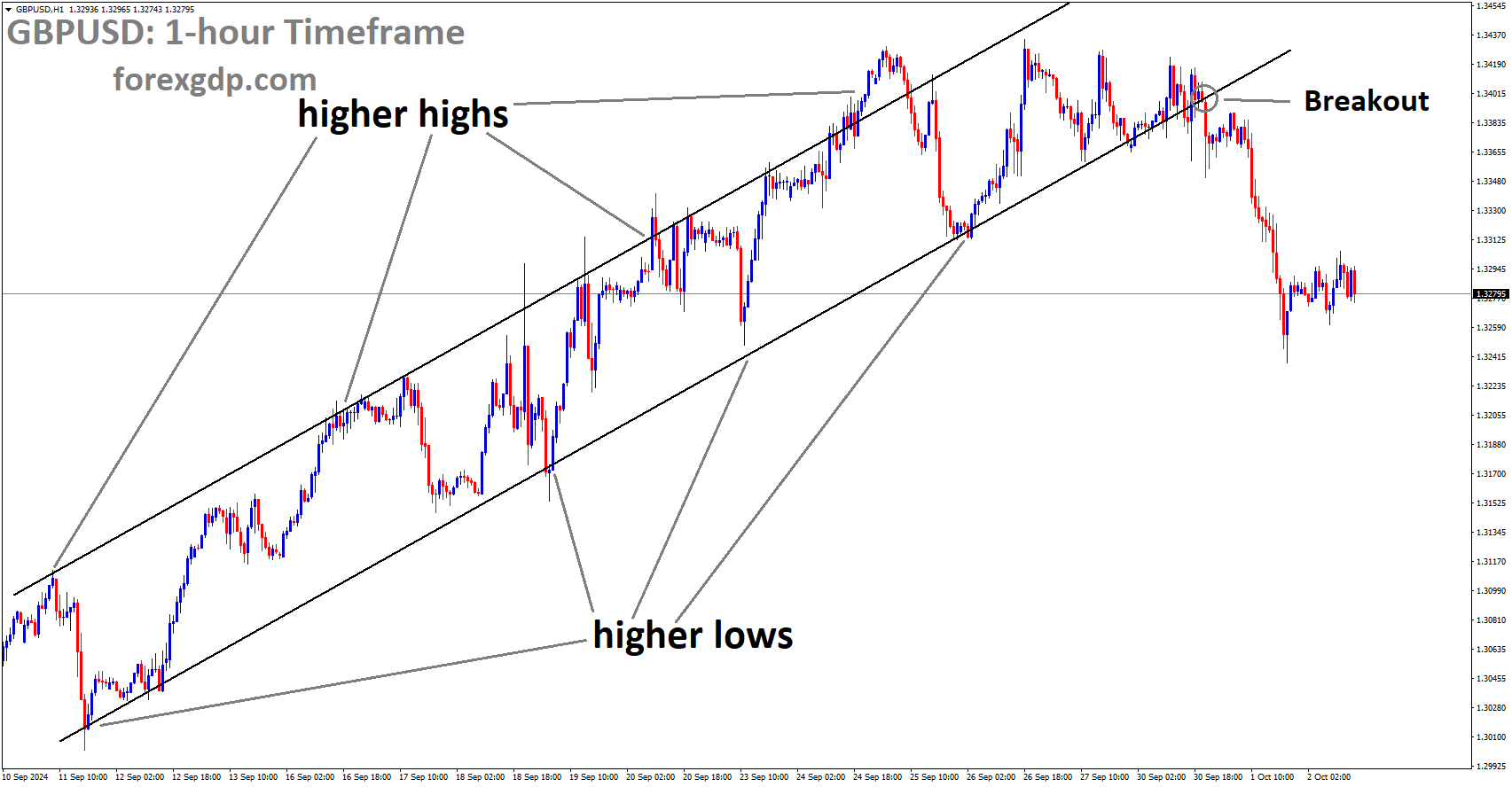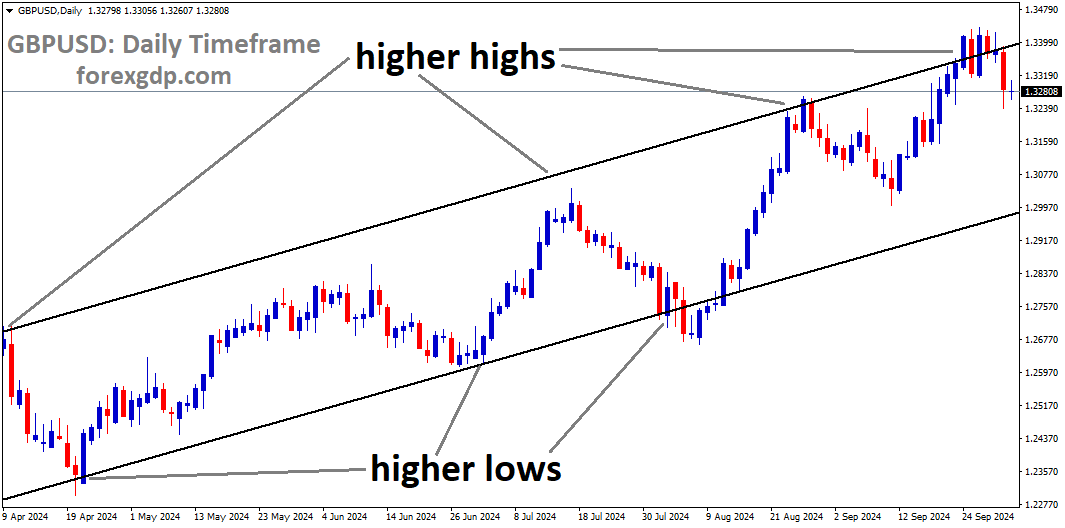GBPUSD is moving in a descending channel, and the market has reached the lower high area of the channel
#GBPUSD Analysis Video
GBP/USD Faces Geopolitical and Economic Headwinds: What’s Next for the Pound?
The GBP/USD pair has been struggling lately due to a combination of rising geopolitical tensions and economic challenges. With Iran’s recent missile launch against Israel and warnings of broader conflict, market participants are seeing risk-aversion sentiment increase, which has weakened the Pound. Meanwhile, policy signals from central banks in both the UK and US continue to shape investor expectations. Let’s dive into the key factors at play for GBP/USD and explore what could be ahead for this major currency pair.
Geopolitical Tensions Stir the Markets
Middle East Conflict Escalates
One of the most pressing issues currently weighing on global markets, and particularly risk-sensitive currencies like the British Pound, is the escalating conflict in the Middle East. Recently, Iran launched over 200 ballistic missiles at Israel, prompting widespread alarm. This event followed warnings from the United States that an attack might be imminent. While some of these missiles were intercepted, reports indicated that casualties occurred, raising concerns about further escalation.
Israeli Prime Minister Benjamin Netanyahu quickly responded with vows of retaliation, further heightening the tension. Tehran, in turn, warned that any counterstrikes would lead to “vast destruction.” This scenario has left investors jittery, as fears of a broader conflict in the region could impact global markets and investor confidence.
When geopolitical uncertainty rises, risk-aversion typically follows. Investors tend to flock towards safer assets like the US Dollar, which benefits from its safe-haven status, while currencies such as the Pound (GBP) that are more sensitive to global risk sentiment can see declines.
Impact on GBP/USD
The tension in the Middle East has caused a significant shift in market sentiment, pushing investors away from risky assets like GBP and towards safer alternatives like the US Dollar. This has contributed to a lackluster performance for the GBP/USD pair, which has remained under pressure. Geopolitical uncertainties tend to spark volatility in the foreign exchange market, making traders cautious about holding positions in more volatile currencies like the Pound during uncertain times.
Additionally, these geopolitical events can have indirect effects on the global economy, which may affect the economic outlook for the UK. Trade disruptions, rising energy prices, and broader market instability could weigh on growth prospects for the UK, leading to further weakness for the Pound.
Economic Uncertainty: Interest Rate Talk from Central Banks
Bank of England’s Dilemma
Amidst these geopolitical tensions, the Bank of England (BoE) is also making headlines with its monetary policy. Megan Greene, a policymaker at the BoE, recently highlighted that interest rate cuts are likely to continue, as inflation appears to be moving in the right direction. This suggests that the central bank believes it has some room to ease monetary policy, particularly given the consumption-driven recovery in the UK.
GBPUSD has broken the Ascending channel in the downside
However, Greene also warned that a recovery fueled too much by consumer spending could risk igniting another round of inflation, a scenario that the BoE is keen to avoid. Inflation has been a hot topic in the UK, and even though prices are starting to stabilize, the threat of inflationary pressures remains a concern.
There is also debate about what constitutes a “neutral” interest rate for the BoE, which refers to the rate that neither stimulates nor restrains economic growth. Greene noted that this rate may have risen since the inflation shock, though she did not specify a figure. Most estimates peg the neutral rate for the BoE around 3.5%. This ongoing discussion about interest rates plays a crucial role in shaping the market’s expectations for the GBP/USD pair.
The Federal Reserve’s Influence
Across the Atlantic, the US Federal Reserve (Fed) is also influencing the direction of the GBP/USD pair. In his recent speech, Fed Chair Jerome Powell reiterated that the central bank would gradually lower interest rates over time, signaling a cautious approach to monetary policy changes. Powell emphasized that the recent rate cuts should not be interpreted as a sign of aggressive future actions. Instead, the Fed plans to take a more measured approach, with modest adjustments likely in the coming months.
GBPUSD is moving in an Ascending channel, and the market has fallen from the higher high area of the channel
This gradual stance from the Fed has provided some support for the US Dollar, as markets interpret this as a steady approach to managing inflation and ensuring economic stability. While the Pound has struggled, the US Dollar has been able to hold its ground thanks to this cautious yet optimistic outlook from the Fed.
What to Watch: Upcoming Reports and Central Bank Comments
With the ongoing geopolitical risks and central bank policies in mind, traders and investors will be keenly watching for any new developments. Two upcoming events, in particular, could provide additional clues about the future of the GBP/USD pair:
- US ADP Employment Change Report: Scheduled for release soon, this report will give investors a snapshot of the US labor market. Strong job growth numbers could bolster confidence in the US economy and provide further support for the Dollar, while weaker numbers might raise concerns and pressure the currency.
- BoE Monetary Policy Report Hearings: Later this week, the Bank of England will hold its Monetary Policy Report Hearings, offering more insights into its plans for interest rates and economic forecasts. Markets will be closely watching these hearings for any hints about future rate cuts or changes to the BoE’s inflation outlook.
The GBP/USD pair faces a challenging environment due to a combination of geopolitical tensions and central bank policy shifts. The escalating conflict in the Middle East has driven risk-aversion in global markets, putting pressure on risk-sensitive currencies like the British Pound. At the same time, monetary policy signals from both the Bank of England and the US Federal Reserve are adding further layers of uncertainty.
For traders and investors, the key will be to monitor developments on both fronts closely. Geopolitical risks may cause further volatility, and any changes in central bank policies could have significant implications for the direction of the GBP/USD pair. It’s a time of heightened uncertainty, but with careful attention to these factors, opportunities may emerge for those able to navigate the complex landscape. Keep an eye on upcoming reports and comments from policymakers, as these will likely offer more clues about what lies ahead for the GBP/USD.
Don’t trade all the time, trade forex only at the confirmed trade setups
Get more confirmed trade signals at premium or supreme – Click here to get more signals , 2200%, 800% growth in Real Live USD trading account of our users – click here to see , or If you want to get FREE Trial signals, You can Join FREE Signals Now!










Your blog post was like a warm hug on a cold day. Thank you for spreading positivity and kindness through your words.